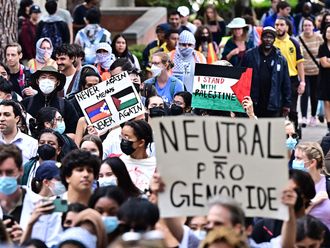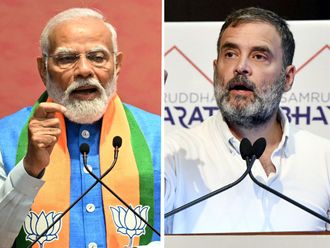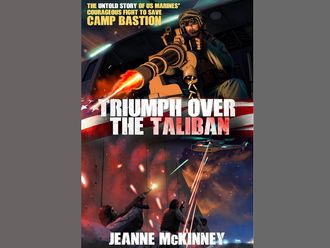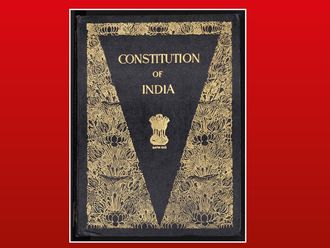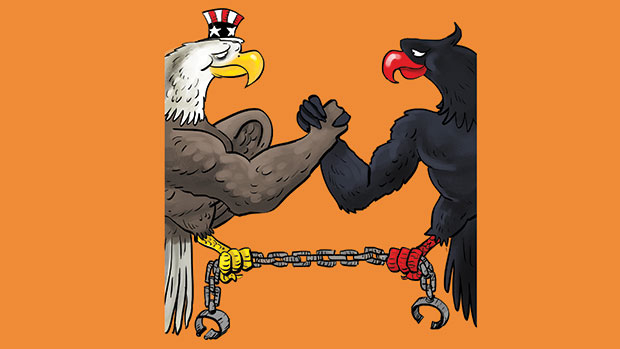
Twenty-five years ago, Germany and Europe were on the threshold of an appointment with history. In May 1989, the then US president George HW Bush told a reporter that he “would love to see Germany reunified”. The country, he said, was a “solid democracy” that had “done penance for its sins and that at some point, you should let a guy up”. I was reminded of those comments — and the logic that guided US strategy in 1989 — when the German President, Joachim Gauck, spoke to the Munich Security Conference earlier this year. He pointed to the great success of German policies in the second half of the 20th century: “This is a good Germany, the best we’ve ever had ... a reliable partner in Europe and the world.” Shortly after Bush endorsed German unification, he delivered a speech in Mainz titled ‘Partners in Leadership’, in which he set forth his vision of “a Europe whole and free”. His strategy relied on strengthening a partnership with Germany in a unified Europe. Throughout the Cold War, the attention of US presidents focused first on the Soviet Union. But they eventually recognised that America’s real priority was to forge durable bonds with Germany and the European allies. Bush’s call recognised Germany’s continuing importance in the future Europe. This strategic concept for Germany and Europe guided US diplomacy during the negotiations for unification in 1990. Over the years, both Germany and the US fell short of the strategic aim of 1989. Yet, the US assessment of 1989 has come to pass. Germany’s size, its success and the financial crisis have revealed the reality that it is dominant in Europe, even as it seeks not to be perceived as dominating. I understand the historical and human reasons for this German caution.
Nevertheless, as Gauck explained, “change is gradually gnawing away German certainties”. The question facing Berlin now is whether it has shown “enough initiative” to ensure the network of norms, friends and alliances that delivered “peace in freedom and democracy in prosperity”.
Rick Burt, a former US ambassador to Germany, notes Berlin and Washington are beyond the era of initial fascination of the 1950s and 1960s. We are also beyond the big fights of the 1970s and 1980s about nuclear strategy and negotiations. Each has taken the other a bit for granted. The US and Germany know one another’s strengths and weaknesses — and are willing to work with them. It is time for both sides to launch a serious strategic dialogue about the changing world. Germany still lives on a frontier — but not of contesting armies. It is now on the frontier of contending ideas. Perhaps Americans can learn about Germany’s longer-term perspective and plans. Perhaps Germans can determine whether US policies seem coherent and aligned with its resources, capabilities, values and will. One topic may be Europe itself. Germany has earned a serious but magnificent responsibility — to be among the standard-bearers for whatever “Europe” might mean in the future. The US has had an interest in European integration since the Marshall Plan of 1947 and the founding of Nato in 1949. Another subject would be the approach to Russia, Ukraine, Moldova, the states of the Caucuses and the Balkans. Germany will be the principal country in shaping European policies and negotiating internal European Union (EU) understandings on these topics. The EU’s neighbourhood to its south is a picture of tumult.
Some observers draw analogies to the 30-year war in Europe. The US, Germany and others in Europe need a common assessment of the dangers — and opportunities. America has an interest in whether Germany and the EU will have a role in Asia beyond commercial ties. The US may start by explaining its approach to the proposal from Chinese President Xi Jinping for a “new type of great power relationship”. Wolfgang Schauble, German Finance Minister, has presented ideas about economic shifts in global power relations. The US and Germany should cooperate on this transformation of the rules, institutions and expectations that underpin globalisation. One key feature will be completion of the Transatlantic Trade and Investment Partnership. There is another critical insight from 1989: The driving force for unity came from the German people — east and west. Diplomacy had to reflect this public sense of imperative.
Fortunately, the American public’s fraternity with freedom served the world well in 1989. Strategic vision must be connected to public support. Perhaps German sensitivities to the past, combined with an American focus on the future, can forge a wise partnership for another generation.
— Financial Times
Robert Zoellick served as a US undersecretary of state from 1989 to 1992 and helped negotiate Germany’s unification.





